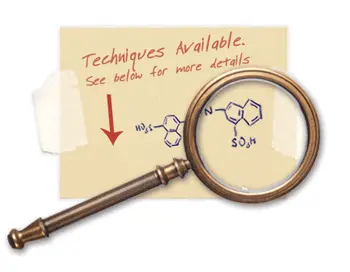Identify an unknown or confirm the composition of a sample...
Triclinic Labs offers inorganic analytical laboratory testing capabilities and techniques to test and
measure inorganic elements and phases in solid and liquid samples.
We have extensive analysis experience with synthetic materials, industrial by products/waste, corrosion
materials, contaminants, catalysts, intermediates, minerals, cement, metals, strategic materials,
semiconductors, ceramics .... basically all industrial relevant inorganic and organic solids.

Phase Identification and Characterization using X-ray Powder Diffraction (XRPD):
| Application AND Technique Description | ||
|---|---|---|
|
X-ray powder diffraction is most widely used for the identification of unknown crystalline materials
(e.g. minerals, inorganic compounds). Determination of unknown solids is critical to studies in
geology, environmental science, material science, engineering, and polymer sciences. In addition to
routine crystalline phase identification, we are able to develop specific methods for quantitative and
semi-quantitative analysis depending on the system of interest. Solid state materials are often more
than just a sum of individual phases, often requiring characterization of the complete sample matrix
(micro-structure, texture, crystalline/non-crystalline, solid-solution) in order to isolate key
material characteristics and to determine the relationship between the matrix and key material
properties. Triclinic labs has developed a number of unique analytical methods for the
characterization of the solid-state matrix. These techniques can be used for more complex materials
and to determine the matrix variability under controlled environmental conditions.
Each chemical molecule (or phase) reflect X-rays slightly differently and have different diffraction patterns. A mixture of compounds gives a pattern that is made up of the patterns of all the individual components. To identify the components present in a mixture the XRD pattern obtained is compared to a large database of patterns. Often the spectra are overlapping so experience and judgment are important. When phase identification is complete the components (phases) are classified as major, minor, or trace. |
||
| Instrument | Model | Notes: |
| Rigaku |
SmartLab (3) 1D and 2D, Reflection and Transmission orientations
Powders, Tablets, Thin Films, Drug Product Mapping Transmission and Reflection Geometries Minimal Sample Req.(<5mg) Cu Source and Co Source. HyPix-3000 Detector is a single photon counting X-ray detector with a high count rate of greater than 10⁶ cps/pixel, a fast readout speed and essentially no noise. Variable Temperature, Variable Humidity Stage Glancing Angle and SAXS |
Wiki Reference for XRPD
Frequently Asked Questions about Triclinic's XRPD Services (click here) |
Applications include:
- Characterization of crystalline materials (identification, quantification, micro-structure, texture, micro-crystalline, nano-crystalline...)
- Characterization of non-crystalline materials (meso-phase [ i.e. liquid crystals], glassy and amorphous)
- Characterization of the solid-state matrix (micro-structure, texture, solid-solution, segregation, micro-absorption...)
- Determination of unit cell dimensions through indexing and crystal structure determination from X-ray powder patterns
- Semi-quantitative and quantitative determine of crystalline and non-crystalline phase composition and variance under controlled environmental conditions
- Ability to handle large (<~10cm) and small (>~0.5mm) solid samples, liquids, suspensions, powders and thin films.
FT-IR Infrared Spectroscopy -
Identify known and unknown organic and
inorganic materials
| Application AND Technique Description | ||
|---|---|---|
|
An FTIR spectrometer simultaneously collects high-spectral-resolution data over a wide spectral range.
This confers a significant advantage over a dispersive spectrometer (e.g. Raman), which measures
intensity over a narrow range of wavelengths at a time. FTIR spectrometers are mostly used for
measurements in the mid and near IR regions. The technique is used to obtain an infrared spectrum of
absorption, emission, photoconductivity or Raman scattering of a solid, liquid or gas for
identification. We spectrally match acquired spectra to our databases of over 1.5 million known
compounds.
The term Fourier-transform infrared spectroscopy originates from the fact that a Fourier transform (a mathematical process) is required to convert the raw data into the actual spectrum. Since information from all wavelengths is collected simultaneously. It results in a higher signal-to-noise ratio for a given scan-time. Attenuated total reflectance (ATR) ATR is an accessory used to measure surface properties of solid or thin film samples rather than their bulk properties. Generally, ATR has a penetration depth of around 1 or 2 micrometers depending on your sample conditions. |
||
| Instrument Brand | Model | Notes: |
| Thermo |
iS50, Model 60825
Nicolet 6700 ATR, diffuse reflectance, transmission, gas cell, spectral library matching. Omnic 9.7.46 Software |
Wiki Reference for
FTIR
|
Applications include:
- Quick determination of whether carbonates, phosphates, nitrates, nitrites, numerous minerals, or water are present with relative quantitative measurement
- Measures surface coatings and treatments to a 1 to 2 μm depth
- Detect variations in an organic coating thickness over a different organic substrate material
Other Tests:
Thermo Gravimetric Analysis (TGA)
Determine thermal characteristics and chemical identity
| Application AND Technique Description | ||
|---|---|---|
| TGA is used to determine characteristics of materials such as degradation temperatures, absorbed moisture content, the level of inorganic and organic components in materials, decomposition points, and solvent residues. TGA can be used to evaluate the thermal stability of a material. Using TG-IR, the TGA instrument continuously weighs a sample as it is heated. As the temperature increases, various components of the sample are decomposed and the gasses can be measured and identified using infrared spectroscopy (TG-IR). The technique is useful for Organics, Thermostable Polymers, and Ceramic materials. | ||
| Instrument Brand | Model | Notes: |
| TA Instruments |
Q50
Discover 5500 DTGS detector TGA/IR interface accessory Evolved gas furnace (gas cell heats to 250 °C and the transfer line goes to 225 °C.) Nitrogen or helium purge. Thermal Advantage Release 5.5.3 5500 Discovery with Trios v.4.3.1.39215 software. |
Wiki Reference for TGA
|
Differential Scanning Calorimetry (DSC)
Detection of phase transitions
| Application AND Technique Description | ||
|---|---|---|
|
By observing the difference in heat flow between the sample and reference, differential scanning
calorimeters are able to measure the amount of heat absorbed or released during phase transitions. The
ability to determine transition temperatures and associated enthalpies makes DSC the go-to technique
for study of first-order transitions, i.e. those involving latent heat such as melting,
crystallization, and water loss from a hydrated crystal. DSC can also be used to measure
characteristic physical properties of materials; absolute heat capacity for example.
In addition, subtle physical changes associated with second-order transitions can be detected by DSC. An example is the glass transition event, which occurs because of the decrease in viscosity (increase in molecular mobility) that follows heating of an amorphous solid. Although viscosity increases in a continuous fashion with heating, a discontinuous glass transition is detectable by DSC when molecular motion in the test sample occurs on the same time scale as the DSC measurement. DSC has found use in many fields, including the study of chemical reactions, determination of the tertiary structures and binding efficiencies of proteins, and quantitation of the percent crystallinity, examine curing, and define degradation events of polymers. Methods have been developed in which DSC alone can be used to determine solubilities and active pharmaceutical ingredient (API)/excipient compatibilities. Triclinic uses DSC data not only for standard characterization of solid substances, but also as part of a proprietary method of predicting physical stabilities of amorphous APIs or formulations. Our new Discovery 2500 System provides accurate, precise measurement of thermal transitions. The available modulated DSC configuration allows the separation of otherwise overlapping events. |
||
| Instrument Brand | Model | Notes: |
| TA Instruments |
TA Instruments - Q 2000, and Q2500 Discovery Systems
Thermal Advantage Software (5.5.3) |
Wiki Reference for
Differential Scanning Calorimetry
|
Karl Fischer (KF) titration
Determine trace amounts of water
| Application AND Technique Description | ||
|---|---|---|
|
Karl Fischer (KF) titration is a fast, accurate, and precise method for determining the water content
in liquids and solids. The water content is measured automatically using a KF titrator, and takes only
minutes to perform. The KF titration is selective for water. By contrast, the loss on drying method
requires several hours to obtain results and the weight loss observed might not be due completely to
water content. Materials that are highly hygroscopic should be prepared for testing under nitrogen.
We offer three types of KF titration methods: Coulometric KF - Coulometric KF titration is suitable for samples with a low water content, e.g., 1 ppm to 5%. Volumetric KF - Volumetric KF titration is suitable for samples with a water content in the range 100 ppm to 100 %. Coulometric/Volumetric KF with Drying Oven - Coulometric/volumetric KF titration with a drying oven attachment is suitable for insoluble materials, or materials that undergo side reactions using conventional KF titration reagents. |
||
| Instrument Brand | Model | Notes: |
| Mettler Toledo | V20 and C20 (Coulometric, Volumetric, Oven) |
Wiki Reference for Karl Fisher
Titration
|
UV/Vis
Quantitative determination of components
| Application AND Technique Description | ||
|---|---|---|
| Routinely used in analytical chemistry for the quantitative determination of different analytes. The presence of an analyte gives a response assumed to be proportional to the concentration. UV/Vis can also be applied to determine the kinetics or rate constant of a chemical reaction. | ||
| Instrument Brand | Model | Notes: |
| PerkinElmer | Lambda 25 | Wiki Reference for UV/Vis |
Elemental analysis, detection, identification, and quantification:
Elemental analysis and testing includes identification and quantification of elements, elemental compounds and molecular species. Sample types and matrices tested for trace elements include organic and non-organic, aqueous and non-aqueous materials. Elemental trace and ultra-trace analysis detection ranges from parts per million (ppm), to parts per billion (ppb) and parts per trillion (ppt) levels, using proven techniques.
| Application AND Technique Description | ||
|---|---|---|
|
Elemental analysis is a qualitative and quantitative process for identifying the elemental composition
of materials (e.g., chemical compounds, minerals, metals, fluids). Certain elemental techniques can
even identify the isotopes of a given element.
We offer several techniques: Energy Dispersive X-ray - (EDX) is a rapid technique for identifying the elements from beryllium to uranium in solid materials. EDX uses an electron beam to stimulate the emission of characteristic x-rays of the elements from the sample surface. The elemental results are presented in an x-ray spectrum. EDX can be used to analyze localized areas or generate chemical maps. Both qualitative and quantitative analyses can be performed. (Triclinic Labs typically uses EDX for the identification of contaminants.) Inductively coupled plasma mass spectrometry (ICP- MS) is a highly sensitive technique used to detect trace elements within solid and liquid samples. ICP - MS works by dissolving the sample in an acid solution before ionizing it with inductively coupled plasma and then using the mass spectrometer to separate and identify the resulting ions and . Because the technique can identify elements at concentrations as low as parts per trillion, ICP-MS is useful in determining elemental impurities for most elements on the periodic table (excluding halogens) and can be used in USP <232> and <233> testing. Trace metals detected and measured by ICP and ICP-MS:
Proton Induced X-Ray Emission (PIXE) is a non-destructive technique that can identify elements from sodium to uranium in solids, liquids, and aerosol filters. It uses a proton beam to excite an electron shell change to force the emission of detectable X-rays. PIXE can be used to analyze multi-element samples because each element's X-rays are characteristic of the element and do not overlap with each other.
|
||
| Instrument Brand | Model | Notes: |
| Various | Various | |
Inorganic Analysis Service Levels Available:

